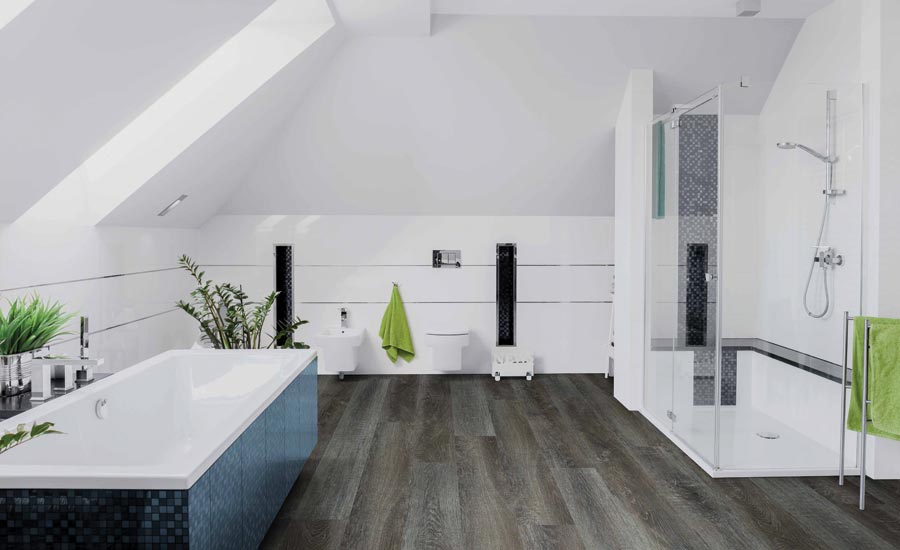LVT Sellers Guide: A Primer for Retail Sales Associates


Marianas Oak, a product from USFloors’ COREtec Plus Enhanced collection.






Luxury vinyl continues to be the hottest category in flooring and for good reason. As we look at the flooring industry and its most recent dynamic change—the explosive growth of luxury vinyl tile (LVT) and the multilayer flooring (MLF)—growth has come about because of immense innovation. By solving problems and providing beautiful aesthetics, these innovations are capturing the hearts and dollars of the consumer.
LVT and multilayer flooring answer so many needs in both residential and commercial settings: they are wear and stain resistant, easy to clean, quieter than other hard surfaces and hardworking options wherever the threat of moisture may be present.
For more of the latest in LVT, click here!
With the array of styles, colors and new technologies, LVT can emulate the looks and textures of natural materials, such as wood and stone, in addition to manmade materials, such as concrete, metal and porcelain tile. These vinyl products come in a variety of formats and with various installation options: glue-down and locking systems.
“The technical advancements that took 20 years in the laminate category took months in the WPC/SPC category,” according to Piet Dossche, USFloors’ president and Shaw’s executive vice president of hard surfaces.
These advancements include wide, long planks, large tile formats, multiple widths and random lengths, attached underlayments—not to mention enhanced features that upgrade the look of these floors like textured surfaces and embossed in register.
Dossche said there has been a surge in the number of rigid core manufacturers in recent years because the cost of entry into producing this equipment is low compared to other flooring types. A smaller single extruder, for example, can cost around $250,000. Short equipment lead times of 90 to 120 days make it easier for companies to ramp up manufacturing, and the equipment is easy to install and operate. Needless to say, with so many companies in the marketplace, it’s important to “be aware and what you buy, who you buy from,” Dossche said.
To help bring clarity to the market, the Multilayer Flooring Association was established to develop the standards of performance, quality and safety for the category, and also avoid product destruction and price erosion so that everyone in the business chain can benefit from these technological advances long term.
It can be overwhelming for product buyers and retail sales associates to navigate all the products and benefits of LVT and multilayer floor products on the market. While nothing beats in-depth product knowledge training by suppliers, we’ve pulled together a quick primer on where this ever-changing market stands today.
How to Win with LVT
- Focus on quality: know who you are working with and what you are buying.
- Focus on profitability: Sell at high margins.
- Become the expert: Ask for training from your suppliers.
- Surround yourself with excellence: your suppliers, your associates, your installers.
- Make your showroom beautiful: declutter and edit down the options.
- Focus on your customer: be transparent, authentic, provide value and a seamless shopping experience.
LVT Constructions
The term “luxury vinyl tile” is an industry-accepted term to denote vinyl-based tile floors. LVT comes in flexible and rigid-core constructions. Each manufacturer will make variations to the composition and structure to create their own unique brand of LVT. Retailers provide a variety of types of LVT to accommodate different projects, and installation methods will depend on a number of factors, such as preference and type of type of subfloor.
Flexible LVT is Made with Several Layers.
Glue-down LVT: From the bottom up, the actual vinyl is in the bottom layer of these floors, also known as the backing, and can consist of vinyl or a mixture of vinyl and limestone. The backing and a middle layer combined provide a stable foundation that offers strong resistance to pressure. The printed layer gives the floor its unique style, color and pattern. The top layer is a transparent wear layer provides durability and the top coating provides stain, fade and scratch resistance.
Hard-set versions of glue-down LVT require a special vinyl glue for installation, which is applied to the floor before the tiles are installed. These floors are often used in heavy-duty environments, such as hospitals or retail that see high traffic and heavy loads. A downside to these floors is that they are more difficult to remove if you want to change the floor in the future.
Pressure-sensitive versions are great for projects that may require the floors be changed often to accommodate brands or changing styles, such as hospitality or retail. There is no need to use any extra glue for installation. To install them, pull back the covering film and position the tile where you need it. To activate the adhesive layer, press down on the tile. One advantage of self-adhesive LVT is that they are equally easy to remove.
Floating LVT: The bottom layer is a multi-layer vinyl core made of soft, pliable plasticizers. The second layer is the printed layer that gives the floor its unique style, color and pattern. The top layer is transparent wear layer, typically in 8-, 12-, or 20-mil. thicknesses, which protects against wear and provides cleanability and resistance.
Instead of using an adhesive, individual tiles and planks have tongues and grooves on their edges to allow easy interlocking. These tiles can be installed in a few hours and can be used immediately, and removal is fairly easy.
Floating floors have found their niche in residential projects and multi-family housing and can sometimes be installed over old adhesives to avoid owners from having to mitigate the removal of asbestos. These floors may also be specified for use in light commercial projects.
Loose-lay LVT: These floors will have multiple layers, ranging from the bottom vinyl layer, various middle layers that provide strength and resistance, a printed layer, a wear layer and a top coat. These types of LVT floors do not rely on adhesive or interlocking mechanisms. Instead, they have a special high-friction bottom that grips the subfloor. Removal is easy.
Technological advancements have made the rigid LVT category of the market grow at an insanely fast rate. In fact, this portion of the market will account for nearly 50 percent of the overall resilient category by 2020, according to Dossche. Why? It’s because technology has made it possible for these floors to closely capture the look wood and stone products—with a lower price tag—and waterproof technology and coatings have made them easy to maintain.
Rigid LVT is Made Up to Two Constructions:
WPC: Wood plastic composite products represent the class of rigid LVT with an expanded foam polymer core. A foamed-up extruded core has built-in air pockets to provide additional comfort underfoot and sound dampening. It’s best suited for residential and light commercial applications.
SPC: SPC products refer to the class of rigid LVT products with a solid polymer core. A dense, highly mineral-filled extruded core provides superior indentation resistance. It’s best suited for high-traffic and commercial applications.
LVT Selling Points
Looking for a reprint of this article?
From high-res PDFs to custom plaques, order your copy today!












